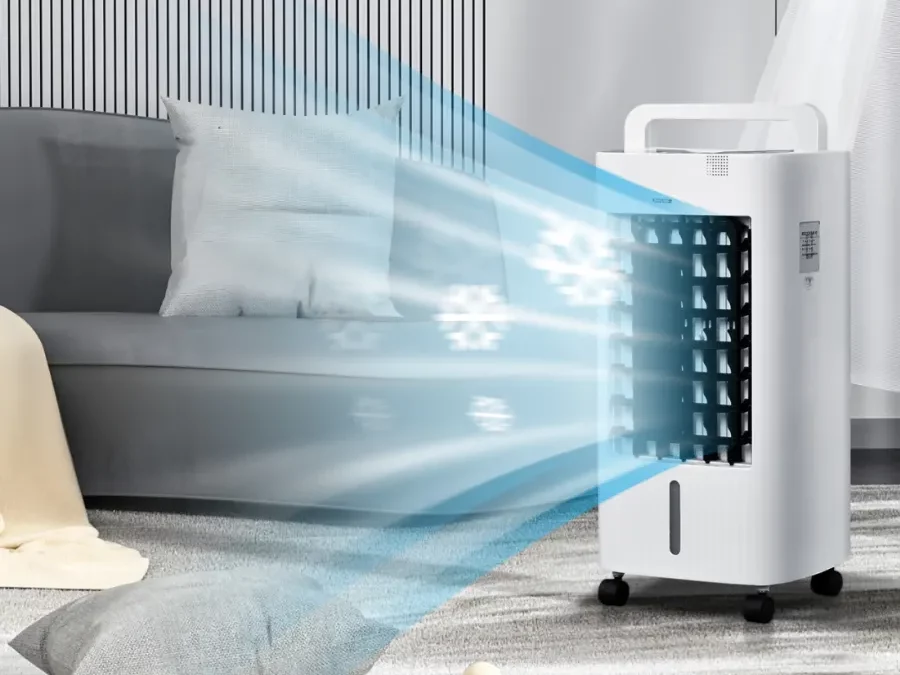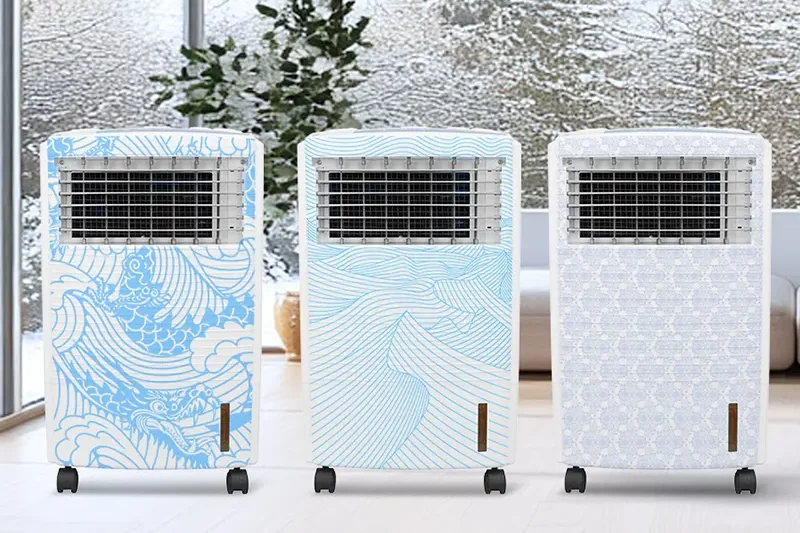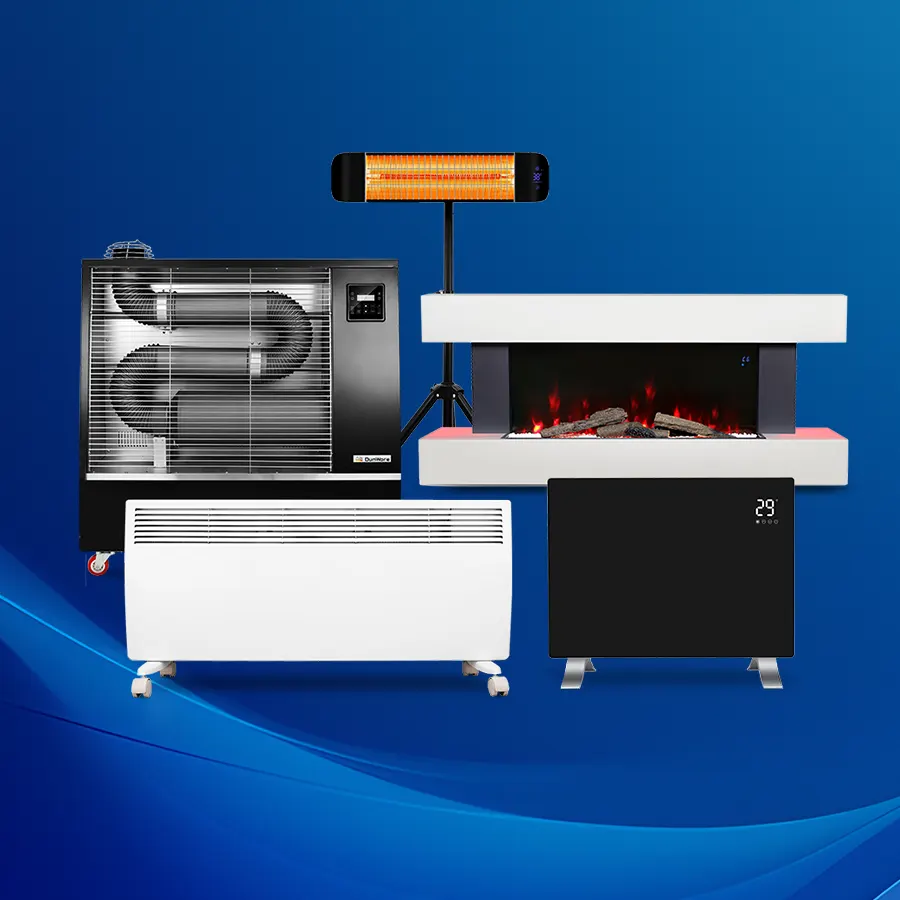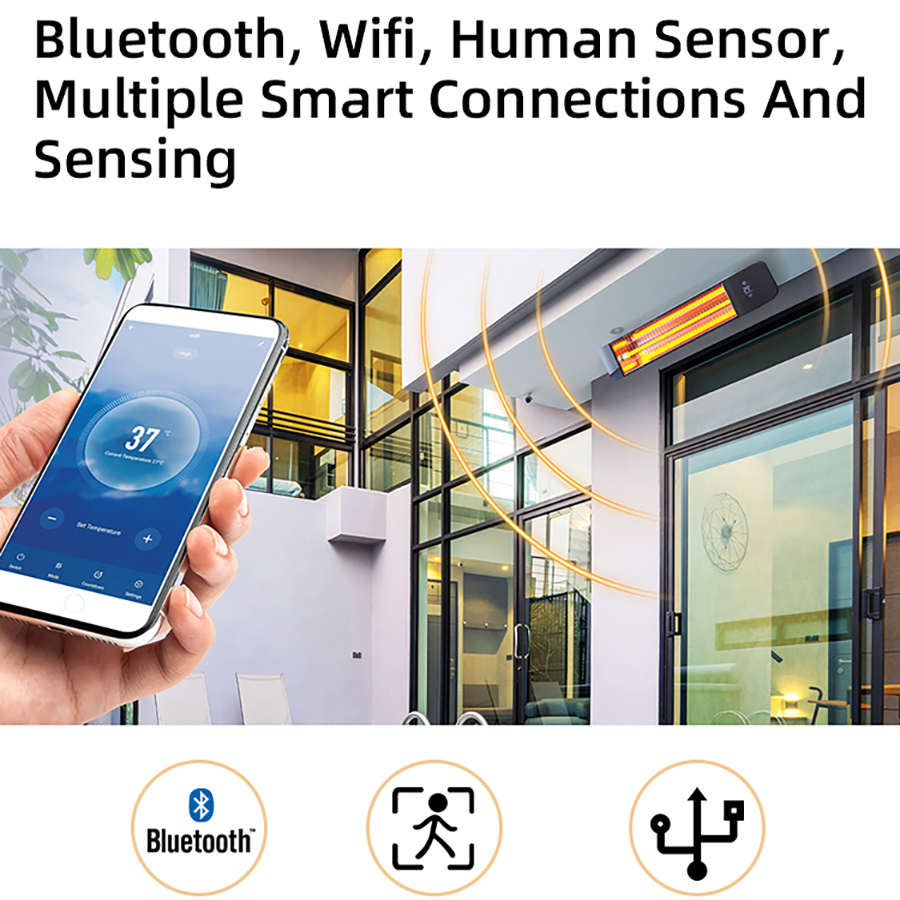시원함을 유지하는 것이 필수적입니다, 특히 여름 더위가 시작될 때. 그러나 너무 많은 종류의 공기 냉각기가 있습니다., 어느 것이 당신에게 적합한 지 어떻게 알 수 있습니까?? 공기 냉각기는 다양한 형태로 제공됩니다, 각각 특정 환경 및 냉각 요구를 위해 설계되었습니다. 집을 시원하게 유지하려고하든, 작업 공간을 더 편안하게 만드십시오, 또는 효율적으로 넓은 넓은 산업 공간, 공기 냉각기 유형과 용도를 이해하면 올바른 선택을 할 수 있습니다.. 다이빙합시다 9 공기 냉각기의 유형과 그들이 가져 오는 장점.
공기 냉각기 란 무엇입니까??

공기 쿨러 물을 증발시켜 공기를 식히는 장치입니다, 에어컨에 대한 자연적이고 에너지 효율적인 대안을 제공합니다. 따뜻한 공기를 그립니다, 물 포화 패드를 통해 전달합니다, 냉각기 공기를 환경으로 다시 방출합니다. 두 가정에 이상적입니다 산업 공간, 공기 냉각기는 건조 기후에 효과적이며 비용 효율적인 것을 제공합니다., 친환경 냉각 솔루션.
냉각 메커니즘을 기반으로 한 공기 냉각기 유형
1. 증발식 공기 냉각기
증발 공기 냉각기, 늪 냉각기라고도합니다, 공기를 식히기 위해 자연적인 물 증발 과정에 의존. 그들은 따뜻한 공기를 당깁니다, 물 포화 패드를 통해 전달하십시오, 그런 다음 쿨러를 날려 버립니다, 더 습한 공기. 호수 옆에 더운 날에 부드러운 바람과 같다., 오른쪽?
이 냉각기는 뜨거운 상태에서 가장 잘 작동합니다, 습도 수준이 낮은 건조 기후. 그들은입니다 이상적입니다 야외 파티오, 워크샵, 그리고 넓은 열린 실내 공간. 사막이나 건조한 지역에있는 경우, 증발 냉각기는 간단한 것을 제공 할 수 있습니다, 에너지 효율적인 방법을 식히는 방법.
증발 냉각의 가장 큰 장점 중 하나는입니다 에너지 효율. 전통적인 에어컨 장치에 비해 전력이 적습니다.. 을 더한, 친환경적입니다, 물을 사용하여 공기를 식히기 때문입니다, 유해한 화학 물질의 필요성을 줄입니다.
2. 사막 공기 냉각기
사막 공기 냉각기는 매우 뜨겁고 건조한 기후를 위해 설계되었습니다.. 그들은 큰 물 탱크와 강력한 팬이 있습니다, 넓은 영역을 냉각시킬 수 있습니다.
이 냉각기는 건조한 영역에서 사용하기에 적합합니다, 전통적인 AC 유닛이 어려움을 겪는 곳. 사막 공기 냉각기를 실제로 필요한 지역에서 자연 냉각 오아시스로 생각하십시오..
사막 냉각기의 장점에는 에어컨 시스템보다 훨씬 적은 에너지를 사용하면서 큰 공간을 효율적으로 식히는 능력이 포함됩니다.. 을 더한, 그들은 공기에 습도를 더합니다, 건조한 지역에서 필요한 수분을 제공합니다.
사용 환경을 기반으로 한 공기 냉각기 유형
1. 가정용 공기 냉각기
가정용 공기 냉각기 집을 위해 특별히 설계되었습니다, 거실 공간을 식히는 간단하고 효율적인 방법 제공. 이 냉각기는 일반적으로 물 증발을 사용하며 휴대용 또는 고정식 일 수 있습니다., 모델에 따라.
완벽합니다 침실, 거실, 그리고 다른 주거 공간, 가정용 공기 냉각기는 전통적인 에어컨 장치에 대한 훌륭한 대안입니다.. 그들은 특히 작은 방이나 특정 지역의 표적 냉각에 효과적입니다..
그만큼 경제성 가정용 냉각기는 주요 판매 지점입니다. 그들은 에어컨보다 달리기가 훨씬 저렴합니다, 주택 소유자에게 비용 효율적인 옵션으로 만듭니다. 을 더한, 그들은 움직이기 쉽습니다, 당신이 어떤 방을 식힐 수있는 유연성을 제공합니다..
2. 상업용 공기 냉각기
상업용 공기 냉각기 더 큰 공간을 위해 만들어졌습니다 부엌, 레스토랑, 또는 소매 환경. 그들은 더 넓은 지역에 냉각을 제공하도록 설계되었습니다., 종종 더 긴 작동 기간 동안 강력한 팬과 더 큰 수도 탱크를 사용합니다..
이 냉각기입니다 큰 냉각에 이상적입니다, 사무실 건물과 같은 열린 공간, 상점, 그리고 심지어 학교조차도. 강력한 냉각 능력은 발 트래픽이 많은 곳에서 온도를 낮추는 데 완벽하게 만듭니다..
한 가지 큰 장점은 그들의 능력입니다 효율적으로 냉각 광대 한 공간 거대한 에너지 요금을 쌓지 않고. 이 냉각기는 또한 공기 순환을 향상시킵니다, 더 신선한 보장, 더 편안한 환경.
3. 산업 공기 냉각기
산업용 공기 냉각기는 큰 공간에서 온도를 조절하도록 설계된 고용량 냉각 시스템입니다. 공장, 창고, 생산 시설. 전통적인 에어컨과 달리, 그들은 증발 냉각 방법을 사용합니다, 공기를 식히기 위해 물이 증발하는 곳, 비용 효율적이고 친환경 솔루션 제공.
산업용 공기 냉각기는 열 출력이 상당한 환경에 이상적입니다., 근로자의 안락함을 보장합니다, 최적의 온도에서 기계 유지, 전반적인 대기 질 향상. 그들의 주요 장점에는 포함됩니다 낮은 에너지 소비, 탄소 발자국 감소, 에어컨이 덜 실용적이거나 너무 비싸지 않은 시원한 광대 한 지역을 효율적으로 시원하는 능력.
4. 개인/휴대용 공기 냉각기
개인 공기 냉각기는 작습니다, 개별 용도로 설계된 휴대용 장치. 그들은 개인 공간에 이상적입니다 책상, 그리고 침대 옆 테이블, 또는 야외 활동을 위해.
개인 쿨러는 앉아 있거나 자고있는 곳 근처에 작은 공간을 식히는 데 좋습니다.. 그들은 목표 냉각을 제공합니다, 방 전체를 식히지 않고 편안하게 유지하기에 적합합니다..
그들의 가벼운 디자인은 그것들을 만듭니다 엄청나게 휴대용, 그리고 그들은 전통적인 단위보다 적은 에너지를 사용하기 때문입니다, 그들은 개인 냉각을위한 비용 효율적인 선택입니다.
설치에 기반한 공기 쿨러 유형
1. 창 공기 냉각기
창 공기 냉각기는 창에 장착됩니다, 그들이 외부에서 공기를 잡아 당겨 실내에서 순환하기 전에 식히는 곳. 중앙 에어컨이없는 지역에 인기있는 옵션입니다..
이 쿨러는 이상적입니다 집이나 아파트 공간이 제한되는 곳. 그들은 싱글 객실과 작은 아파트에서 잘 작동합니다, 집중된 냉각 효과를 제공합니다.
여기서 주요 공기 쿨러 장점 중 하나는 에너지 효율. 중앙 AC 시스템보다 전력이 적습니다, 작은 공간을위한보다 비용 효율적인 냉각 솔루션 만들기.
2. 타워 에어 쿨러
타워 공기 냉각기는 키가 큽니다, 강력한 냉각을 전달하면서 공간을 절약하도록 설계된 슬림 장치. 그들은 냉각 패드 세트를 통해 공기를 그리고 방을 가로 질러 균등하게 순환하여 작동합니다..
소형 동안, 타워 공기 냉각기는 놀랍습니다 더 큰 방에서 효과적입니다 강한 공기 흐름으로 인해. 그들은 거실에 이상적입니다, 부엌, 또는 바닥 공간이 제한되어 있지만 냉각이 필수적 인 공간.
세련된 디자인과 효율성은 현대 주택에서 가장 좋아합니다.. 그들은 공간을 절약 할뿐만 아니라, 그러나 그들은 또한 현대적인 장식과 잘 조화를 이루며 우수한 냉각을 제공합니다..
3. 덕트 공기 냉각기
덕트 공기 냉각기. 중앙 집중식 에어컨 시스템과 유사하게 작동하지만 더 에너지 효율적입니다..
이 쿨러는 가장 잘 작동합니다 큰 집, 사무실 건물, 또는 창고, 여러 공간에서 일관된 냉각을 위해 중앙 집중식 시스템이 필요한 곳.
중앙 AC에 비해, 덕트 냉각기는 에너지가 적고 환경 친화적입니다., 대규모 냉각을위한 더 똑똑한 선택으로 만듭니다.
다른 환경에서 공기 냉각기의 사용

주거 용도
공기 냉각기는 거실을 냉각하기위한 탁월한 선택입니다., 침실, 그리고 다른 개인 공간. 주택 소유자를 위해, 에너지 절약 팁에는 효율을 극대화하기 위해 온도가 떨어지는 저녁에 사용에 사용됩니다..
상업 및 사무실 사용
작업 공간의 경우, 공기 냉각기는보다 편안한 환경을 조성하는 데 도움이됩니다, 생산성 향상. Air Cooler 상용 및 휴대용 모델과 같은 다양한 유형은 사무실 및 소매 공간에 적합합니다..
산업 및 넓은 공간
공장이나 창고에서, 공기 냉각기는 넓은 영역을 냉각하기위한 비용 효율적인 솔루션을 제공합니다. 그들은 에너지 효율이 높고 최적의 온도 제어를 보장합니다, 까다로운 환경에서도.
올바른 공기 쿨러 선택
고려해야 할 요소 (크기, 기후)
올바른 공기 쿨러를 선택할 때, 영역의 크기와 같은 요소를 고려하십시오, 기후, 그리고 장치의 냉각 용량. 더 큰 공간 보다 강력한 산업용 냉각기가 필요합니다, 작은 개인 쿨러가 이상적이지만 이상적입니다 소형 방. 추가적으로, 마른 기후에서, 증발 냉각기가 가장 잘 작동합니다, 습한 지역에는 다른 유형의 냉각 솔루션이 필요할 수 있습니다.. 이러한 요소의 균형을 유지하면 최적의 냉각 및 에너지 효율이 보장됩니다.
균형 비용과 효율성
선불 비용과 장기 효율성 사이의 균형을 제공하는 공기 냉각기 찾기. 사막과 증발 냉각기는 핫에 이상적입니다, 마른 기후, 최소한의 에너지 사용으로 강력한 냉각을 제공합니다. 반면에, 휴대용 냉각기는 유연성에 적합합니다, 단기 사용, 필요에 따라 방이나 위치 사이에 쉽게 이동할 수 있습니다., 편의성과 다양성을 제공합니다.
장기 투자를위한 팁
오래 지속되는 성능을 위해 평판이 좋은 공기 쿨러 제조업체의 고품질 공기 쿨러에 투자하십시오.. 적절한 유지 보수, 청소 필터 및 리필 워터 탱크와 같은, 또한 시원한 삶을 연장하는 데 도움이됩니다.
결론
냉각 필요에 관계없이, 당신을 위해 공기 쿨러가 있습니다. 증발 공기 냉각기에서 대형 덕트 시스템까지, 다양한 공기 냉각기 유형과 사용은 모든 공간에 무언가를 보장합니다., 예산, 그리고 기후. 다양한 유형의 공기 냉각기와 장점을 이해함으로써, 에너지 비용 절약을하면서 시원하게 유지하는보다 정보에 근거한 결정을 내릴 수 있습니다..
자주 묻는 질문
- 작은 공간에 가장 적합한 공기 쿨러? 개인 또는 휴대용 공기 냉각기는 작은 공간에 이상적입니다., 가장 필요한 곳에 타겟팅 된 냉각을 제공합니다.
- 습한 지역에 적합한 사막 냉각기입니다? 아니요, 사막 냉각기는 가장 잘 작동합니다, 마른 기후. 그들은 습한 환경에서 덜 효과적입니다.
- 증발 공기 냉각기는 어떻게 에너지를 절약합니까?? 증발 냉각기는 물과 공기 흐름을 사용하여 공기를 식 힙니다., 전통적인 에어컨보다 훨씬 적은 전기를 소비합니다.
- DC 공기 쿨러 오프 그리드를 사용할 수 있습니까?? 예, DC 공기 냉각기는 오프 그리드 또는 실외 사용에 적합합니다., 특히 태양 광 발전과 짝을 이룰 때.
- 덕트 공기 냉각기와 중앙 AC의 차이점은 무엇입니까?? 덕트 냉각기.





















